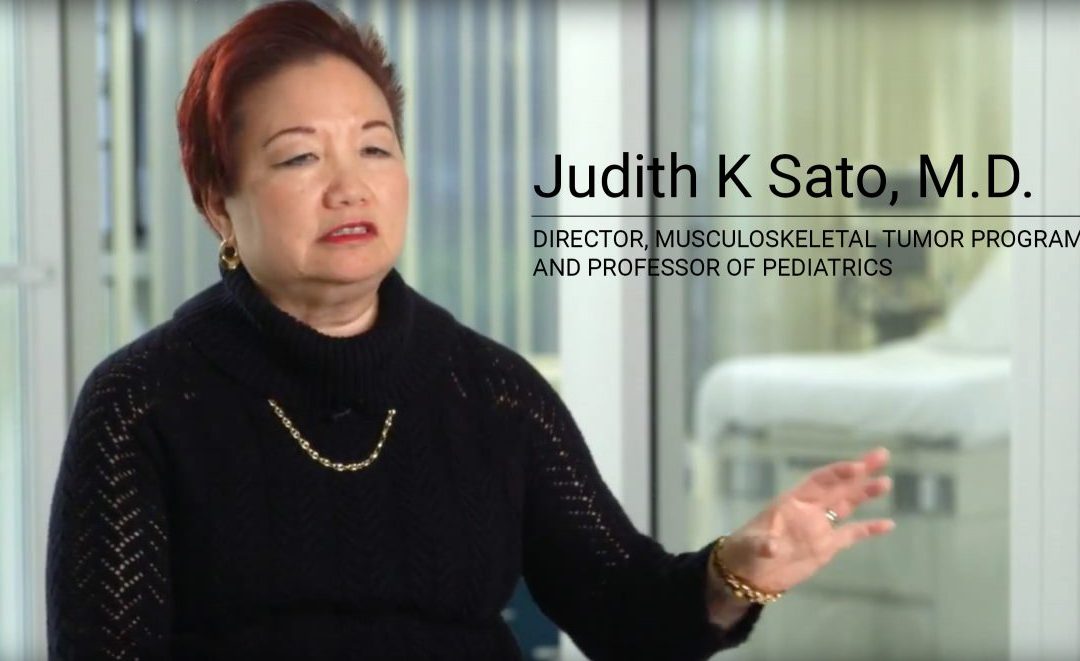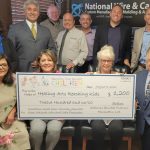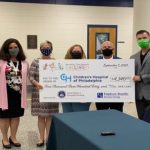[bt_section][bt_row][bt_column width=”1/1″][bt_hr top_spaced=”not-spaced” bottom_spaced=”bottomSmallSpaced” transparent_border=”border” el_class=”” el_style=””][/bt_hr][/bt_column][/bt_row][bt_row][bt_column width=”3/4″][bt_text]
AUGUST 3, 2017 – BREAKTHROUGHS
by Travis Marshall
Duarte, California − Musculoskeletal tumors and sarcomas are so rare and diverse that it’s almost impossible for a single physician to effectively treat them alone.
At City of Hope, Judith K. Sato, M.D., pediatric oncologist and director of the Musculoskeletal Tumor Program, has spent decades building one of the most advanced multidisciplinary programs of its kind. She even offers a musculoskeletal sarcoma clinic where physicians from area hospitals can bring their patients so she and her team can offer their opinions.
“After we consult, they can go back to their own facilities, but many end up moving their patients here,” she said.
That’s because City of Hope is uniquely equipped to provide rapid, comprehensive treatment for these highly aggressive cancers.
[/bt_text][/bt_column][bt_column width=”1/4″][bt_hr top_spaced=”topSemiSpaced” bottom_spaced=”bottomSemiSpaced” transparent_border=”noBorder” el_class=”” el_style=””][/bt_hr][bt_image image=”5120″ caption_text=”” caption_title=”Judith K. Sato, M.D.” show_titles=”yes” size=”full” shape=”square” url=”” target=”_self” el_class=”” el_style=””][/bt_image][bt_text]
Judith K. Sato, M.D.
[/bt_text][/bt_column][/bt_row][bt_row][bt_column width=”1/1″][bt_hr top_spaced=”topSmallSpaced” bottom_spaced=”bottomSmallSpaced” transparent_border=”border” el_class=”” el_style=””][/bt_hr][bt_text]
“These are very fast-growing,” said Sato. “I once consulted on a case where the tumor was in the mandible and they thought it was a dental abscess. By the time I saw the patient, she couldn’t even close her mouth. We saw her in two hours, got her on treatment and saved her life.”
[/bt_text][bt_hr top_spaced=”topSmallSpaced” bottom_spaced=”bottomSmallSpaced” transparent_border=”border” el_class=”” el_style=””][/bt_hr][/bt_column][/bt_row][bt_row][bt_column width=”1/1″][bt_text]
Patients with musculoskeletal tumors, including any of the more 70 known types of sarcomas, need fast, expert care for everything from diagnosis and treatment to social support.
“We’re really trying to educate the physician community to send their patients to us as soon as possible if they suspect one of these tumors, even before they do a biopsy,” said Sato. “An orthopedic surgeon may see something and decide to do surgery. It’s so important to send the patient to a sarcoma center before they do anything.
“If they put the incision in wrong place, it can affect our ability to save the patient’s arm or hip or wherever the tumor is located, because that incision must be removed.”
[/bt_text][bt_hr top_spaced=”topSemiSpaced” bottom_spaced=”bottomSemiSpaced” transparent_border=”border” el_class=”” el_style=””][/bt_hr][/bt_column][/bt_row][bt_row][bt_column width=”3/4″][bt_text]
The Gold Standard
[/bt_text][bt_text]
There is no question that the multidisciplinary approach is the gold standard for cancer care, but for musculoskeletal tumors it’s a necessity.
“In treating the core issue, we need well-concerted elements all acting at different times, and at precisely the right time,” said Joseph Rosenthal, M.D., M.H.C.M., the Barron Hilton Professor and Chair in Pediatrics. “The uniqueness of this program is we have all these subspecialties under one ceiling.”
Having a range of subspecialists means patients have access to a full complement of leading-edge treatments, including minimally invasive surgeries to remove tumors while saving healthy tissue and bone, advanced radiation therapies like helical Tomotherapy, and trials such as one that uses genetically engineered T cells to treat sarcoma.
“We’re also the only institution in Southern California that offers Stanmore expandable prostheses,” said Sato. “These allow us to lengthen the prosthesis as the patient grows without additional surgeries.”
[/bt_text][bt_hr top_spaced=”topSmallSpaced” bottom_spaced=”bottomExtraSmallSpaced” transparent_border=”noBorder” el_class=”” el_style=””][/bt_hr][/bt_column][bt_column width=”1/4″][bt_hr top_spaced=”topSemiSpaced” bottom_spaced=”bottomSemiSpaced” transparent_border=”noBorder” el_class=”” el_style=””][/bt_hr][bt_image image=”5127″ caption_text=”” caption_title=”Joseph Rosenthal, M.D.” show_titles=”yes” size=”full” shape=”square” url=”” target=”_self” el_class=”” el_style=””][/bt_image][bt_text]
Joseph Rosenthal, M.D.
[/bt_text][/bt_column][/bt_row][bt_row][bt_column width=”1/1″][bt_text]
This wealth of expertise has led to a remarkable improvement in outcomes over the last decade. “When I first started, only about 20 percent of patients survived, now it’s 80 percent,” said Sato. “And we’re able to salvage the extremities in about 80 percent of those survivors.”
The multidisciplinary approach also means there is a vast support team helping patients with everything from travel and housing, to family counseling.
“It’s social workers, nurses, a whole team,” said Sato. “These patients are mostly children and young adults, so it’s not just about the patient, but it’s also their family, the parents.
“What effect does this have on their 15-year-old sister? Can you imagine having to bring a child here from Fresno to do treatment every week? We have people to help them arrange all that.”
[/bt_text][bt_hr top_spaced=”topSemiSpaced” bottom_spaced=”bottomSemiSpaced” transparent_border=”border” el_class=”” el_style=””][/bt_hr][/bt_column][/bt_row][bt_row][bt_column width=”1/1″][bt_text]
Pediatric care for patients of all ages
[/bt_text][bt_text]
Not all patients in the pediatric Musculoskeletal Tumor Program are children or young adults. Unlike most pediatric programs, City of Hope has no age ceiling.
“There are many types of sarcoma, and some seem to affect children around puberty. But those same tumors can happen in 30, 40, even 60-year-old people,” said Sato. “Generally, the prognosis in older patients is worse. What we’re looking at is, if we treat them same as we do children, will they do better? So our goal is to offer them the same treatment as we do in childhood cancer.”
It’s a unique approach to treating a unique cancer. And Sato is confident it’s working.
###
[/bt_text][bt_hr top_spaced=”topSemiSpaced” bottom_spaced=”bottomSemiSpaced” transparent_border=”border” el_class=”” el_style=””][/bt_hr][/bt_column][/bt_row][bt_row el_class=”” el_style=””][bt_column width=”1/1″ align=”left” vertical_align=”inherit” border=”no_border” cell_padding=”default” animation=”no_animation” highlight=”no_highlight” highlight_border_color=”” background_color=”” transparent=”” inner_background_color=”” background_image=”” el_class=”” el_style=””][bt_text]
City of Hope is a world leader in the research and treatment of cancer, diabetes, and other serious diseases. We deliver scientific miracles that make lives whole again. Compassion is the heart of our approach and the driving force behind all our discoveries. Founded in 1913, City of Hope is one of only 49 comprehensive cancer centers in the nation, as designated by the National Cancer Institute. Each innovative treatment we create gives people the chance to live longer, better and more fully.
[/bt_text][/bt_column][/bt_row][/bt_section]



